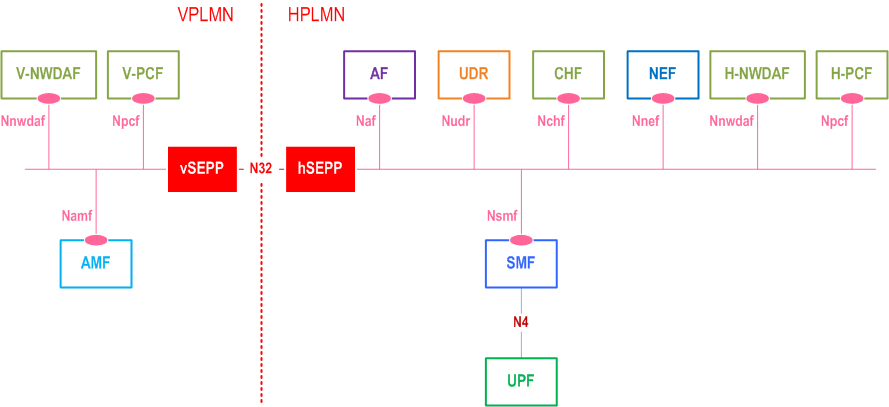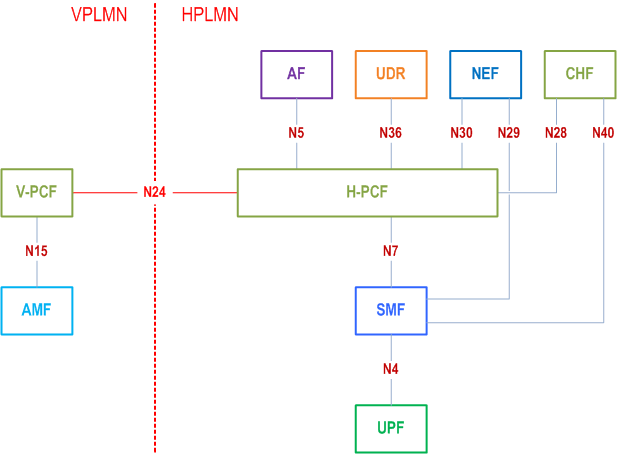Content for TS 23.503 Word version: 19.2.0
0…
4…
5…
6…
6.1.2…
6.1.2.4…
6.1.3…
6.1.3.6…
6.1.3.18…
6.1.3.21…
6.1.4…
6.2…
6.2.2…
6.3…
6.4…
6.6…
A…
C
D…
5 Architecture model and reference points
5.1 General
5.2 Reference architecture
5.2.1 Non-roaming architecture
5.2.2 Roaming architecture
5.3 Service-based interfaces and reference points
5.3.1 Interactions between PCF and AF
5.3.2 Interactions between PCF and SMF
5.3.3 Interactions between PCF and AMF
5.3.4 Interactions between V-PCF and H-PCF
5.3.5 Interactions between PCF and UDR
5.3.6 Interactions between SMF and CHF
5.3.8 Interactions between PCF and CHF
5.3.9 Interactions between SMF and NEF
5.3.10 Interactions between NEF and PCF
5.3.11 Interactions between NWDAF and PCF
5.3.12 Interactions between PCF for the UE and PCF for the PDU Session
5.3.13 Interactions between PCF and TSCTSF
5.3.14 Interactions between NWDAF and NEF (PFDF)
...
...
5 Architecture model and reference points p. 20
5.1 General p. 20
This specification describes the policy and charging control framework for the 5G system. The interaction between network functions is represented in two ways:
- A service-based representation, where network functions enable other authorized network functions to access their services. This representation also includes point-to-point reference points where necessary;
- A reference point representation, which shows that interactions exist between those network functions for which a reference point is depicted between them.
5.2 Reference architecture p. 21
5.2.1 Non-roaming architecture p. 21
The reference architecture of policy and charging control framework for the 5G System is comprised by the functions of the Policy Control Function (PCF), the Session Management Function (SMF), the User Plane Function (UPF), the Access and Mobility Management Function (AMF), the Network Exposure Functionality (NEF), the Network Data Analytics Function (NWDAF), the Charging Function (CHF), the Application Function (AF) and UDR (Unified Data Repository).
Figure 5.2.1-1 shows the service based representation and Figure 5.2.1-1a shows the reference point representation of the reference architecture of policy and charging control framework for the 5G System.


The Nchf service for online and offline charging consumed by the SMF is defined in TS 32.240.
The Nchf service for Spending Limit Control consumed by the PCF is defined in TS 23.502.
The PCF providing session management policy control for a UE (i.e. PCF for the PDU Session) and the PCF providing non-session management policy control for that UE (i.e. PCF for the UE) may be different PCF instances. For the case that there are different PCF instances, the PCF for the PDU Session does not support the N15 reference point while the PCF for the UE does not support the N7 reference point. The N43 reference point enables communication between the PCF for the UE and the PCF for the PDU Session.
5.2.2 Roaming architecture p. 22
Figure 5.2.2-1 shows the local breakout roaming architecture of the policy and charging control framework for the 5G System:


Figure 5.2.2-2 shows the home routed roaming architecture of the policy and charging control framework for the 5G System:


5.2.3 Void
5.3 Service-based interfaces and reference points p. 25
5.3.1 Interactions between PCF and AF p. 25
Npcf and Naf enable transport of application level session information and Ethernet/IP port management information from AF to PCF. Such information includes, but is not limited to:
- IP filter information or Ethernet packet filter information to identify the service data flow for policy control and/or differentiated charging;
- media/application bandwidth requirements for QoS control;
-
In addition, for sponsored data connectivity:
- the sponsor's identification;
- optionally, a usage threshold and whether the PCF reports these events to the AF;
- information identifying the application service provider and application (e.g. SDFs, application identifier, etc.);
- information required to enable Application Function influence on traffic routing as defined in clause 5.6.7 of TS 23.501;
- information required to enable Application Function influence on Service Function Chaining as defined in clause 5.6.16 of TS 23.501;
- information required to enable Application Function influence on Handling of Payload Headers as defined in clause 5.6.17 of TS 23.501;
- information required to enable setting up an AF session with required QoS as defined in clause 6.1.3.22;
- information required to enable setting up an AF session with support for Time Sensitive Networking (TSN) as defined in clause 6.1.3.23.
- information required to enable setting up an AF session with support for Time Sensitive Communication as defined in clause 6.1.3.23a.
- information required to enable setting up an AF session with support for Deterministic Networking (DetNet) as defined in clause 6.1.3.23b.
- information required to enable setting up an AF session with support for eXtended Reality and Interactive Media Services (XRM) as defined in clause 6.1.3.27.
5.3.2 Interactions between PCF and SMF p. 25
Npcf and Nsmf enable the PCF to have dynamic control over the policy and charging behaviour at a SMF.
Npcf and Nsmf enable the signalling of policy and charging control decisions and support the following functionality:
- Creation of a SM Policy Association as defined in clause 4.16 of TS 23.502;
- Request for policy and charging control decision from the SMF to the PCF when a Policy Control Request Trigger related to Session Management has been met;
- Provision of policy and charging control decision from the PCF to the SMF;
- Deletion of a SM Policy Association as defined in clause 4.16 of TS 23.502;
- Forwarding of UE reporting of URSP rule enforcement by SMF to PCF as defined in clause 6.6.2.4.
5.3.3 Interactions between PCF and AMF p. 26
Npcf and Namf enable the PCF to provide Access and Mobility related policy information to the AMF as well as to provide UE policy information to the UE via the AMF and support the following functionality:
- Creation and Deletion of an AM Policy Association as defined in clause 4.16 of TS 23.502;
- Creation and Deletion of an UE Policy Association as defined in clause 4.16 of TS 23.502;
- Request for access and mobility related policy information from the AMF to the PCF when a Policy Control Request Trigger related to Access and Mobility Management, UE access selection or PDU Session selection has been met as defined in clause 6.1.2.5;
- Provision of access and mobility management related policy information from the PCF to the AMF as defined in clause 6.5;
- Handling of transparent delivery of UE policy information from the PCF to the UE via the AMF.
5.3.4 Interactions between V-PCF and H-PCF p. 26
For roaming scenario, the interactions between V-PCF and H-PCF through Npcf enables:
- Creation of an UE Policy Association as defined in clause 4.16 of TS 23.502;
- Relay of notification of changes from the V-PCF in the VPLMN to the H-PCF as defined in clause 4.16 of TS 23.502;
- Provision of UE policy information to the V-PCF in the VPLMN;
- Deletion of an UE Policy Association as defined in clause 4.16 of TS 23.502;
- Provision of Service Parameters of the VPLMN to the H-PCF in the HPLMN.
5.3.5 Interactions between PCF and UDR p. 26
The Nudr enables the PCF to access policy control related subscription information and application specific information stored in the UDR. The Nudr interface supports the following functions:
- request for policy control related subscription information and application specific information from the UDR;
- provisioning of policy control related subscription information and application specific information to the UDR;
- notifications from the UDR on changes in the policy control related subscription information;
- subscription to the UDR for the update of application data;
- notifications from the UDR on the update of application data.
5.3.6 Interactions between SMF and CHF p. 26
The interactions between SMF and CHF enable online and offline charging.
The N40 reference point is defined for the interactions between SMF and CHF in the reference point representation.
Since the N40 reference point resides between the SMF and CHF in the HPLMN, home routed roaming and non-roaming scenarios are supported in the same manner.
5.3.7 Void
5.3.8 Interactions between PCF and CHF p. 27
The Nchf enables the PCF to access policy counter status information relating to subscriber spending from CHF and support the following functionality:
- Request for reporting of policy counter status information from PCF to CHF and subscribe to or unsubscribe from spending limit reports (i.e. notifications of policy counter status changes);
- Report of policy counter status information upon a PCF request from CHF to PCF;
- Notification of spending limit reports from CHF to PCF;
- Cancellation of spending limit reporting from PCF to CHF.
5.3.9 Interactions between SMF and NEF p. 27
Nsmf and Nnef enable transport of PFDs from the NEF (PFDF) to the SMF for a particular application identifier or for a set of application identifiers. It is achieved with the support of the following functionality:
- Creation, updating and removal of individual or the whole set of PFDs from the NEF (PFDF) to the SMF;
- Confirmation of creation, updating and removal of PFDs from the SMF to the NEF (PFDF).
5.3.10 Interactions between NEF and PCF p. 27
Npcf and Nnef enable the negotiation of policy and charging control behaviour between PCF and NEF by supporting the following functionality:
- service specific policy and charging control;
- sponsor data connectivity including usage monitoring;
- Application Function influence on traffic routing;
- Application Function influence on Service Function Chaining;
- Application Function influence on Handling of Payload Headers;
- subscription and reporting of events for the event exposure;
- negotiations for future background data transfer;
- negotiation of planned data transfer with QoS requirements.
5.3.11 Interactions between NWDAF and PCF p. 28
The Nnwdaf enables the PCF to request or subscribe to and be notified on analytics specified in clause 6 of TS 23.288. The specific list of analytics and how these analytics can be used by the PCF is described in clause 6.1.1.3.
The N23 reference point is defined for the interactions between NWDAF and PCF in the reference point representation.
5.3.12 Interactions between PCF for the UE and PCF for the PDU Session |R17| p. 28
Npcf services enable reporting of PDU Session related events detected by the PCF for the PDU Session to the PCF for the UE. Such events are described in clause 6.1.3.18, e.g. reporting the start and stop of application traffic detection and UE reporting of URSP rule enforcement.
5.3.13 Interactions between PCF and TSCTSF |R17| p. 28
Npcf enables transport of application level session information from TSCTSF to PCF and Ethernet or IP port management information between PCF and TSCTSF. Such information includes, but is not limited to:
- information required to enable setting up an AF session with support for Time Sensitive Communication and Time Synchronization as defined in clause 6.1.3.23a.
- information required to enable setting up an AF session with support for Deterministic Networking as defined in clause 6.1.3.23b.
5.3.14 Interactions between NWDAF and NEF (PFDF) |R18| p. 28
The Nnwdaf enables the NEF (PFDF) to request or to subscribe to and to be notified of the PFD Determination analytics as specified in TS 23.288.